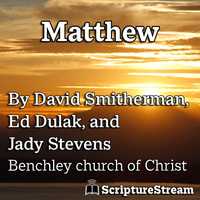Matthew 27
- Matthew 27:1-5 – Judas tries to return the betrayal money, but the Jews refuse to take it back. This fulfilled the prophecy in Zechariah 11:12-13.
- Matthew 27:7-8 – This “field of blood” was a clear geographical fact that early readers of the gospels would have been able to check.
- Matthew 27:11-14 – Jesus did speak, but He did not answer to any charges, in fulfillment of the prophecy in Isaiah 53:7.
- Matthew 27:17-23 – Pilate tried to rally support for Jesus, but when he couldn’t, he bowed to pressure from the crowd and sent Jesus to be crucified.
- Matthew 27:26 – The fact that scourging is mentioned so lightly here indicates that this writing is inspired. A human author would have made much more of this.
- Matthew 27:35 – Like scourging in Matthew 27:26, crucifixion is almost treated as an aside here. The soldiers dividing Jesus’ garments fulfills the prophecy in Psalms 22:18. See John 3:14 where Jesus compares His own death to the bronze serpent.
- Matthew 27:38 – See Isaiah 53:9. Jesus being crucified with criminals and being buried in the tomb of a wealthy man were both prophesied.
- Matthew 27:39-44 – See Psalms 22:7-8. This prophecy is fulfilled almost word for word.
- Matthew 27:46 – See Psalms 22:1.
Matthew 28
- Matthew 28:1-10 – See I Corinthians 15:3-8 – This is a summation of the gospel:
- Christ died.
- He was buried.
- He was raised.
- He appeared to more than 500 people.
- Matthew 28:11-15 – This is one of many theories propounded to try to disprove the resurrection of Jesus.
- Matthew 28:16-20 – Jesus gave the great commission to the eleven disciples. Note Acts 8 where the disciples went everywhere spreading the gospel.
